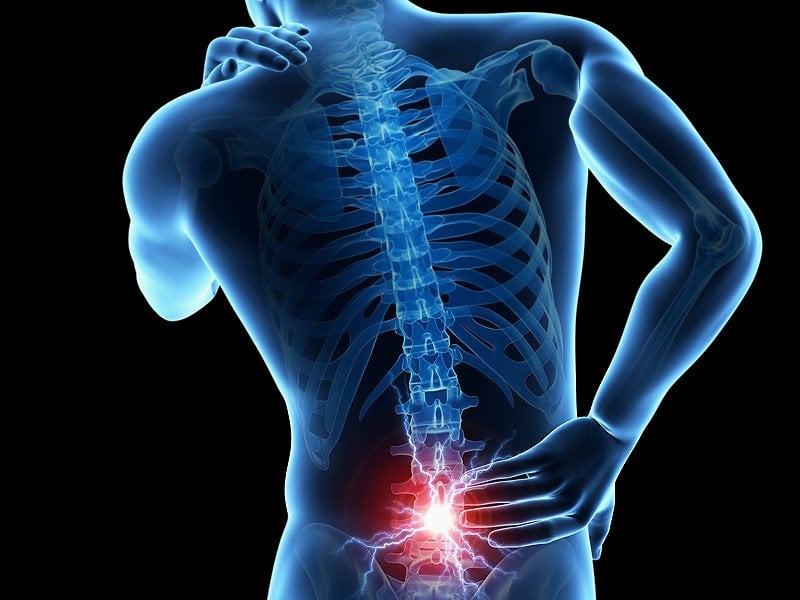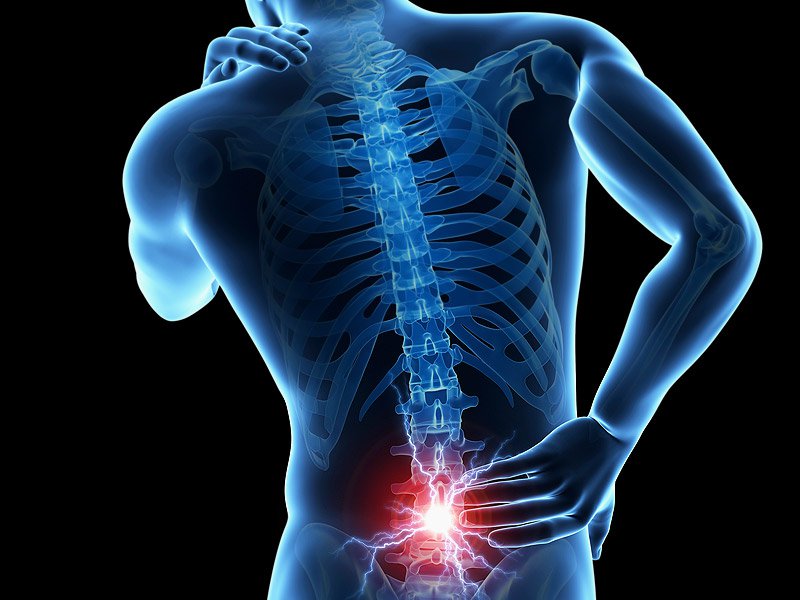The lower back consists of the vertebrae of the spine, muscles, and ligaments. The spine contains intervertebral discs, a kind of cushion made of cartilage that fits between two vertebrae (bone segments). Injury or disease of the muscles, ligaments, or discs of the lower back can cause back pain.
The low back supports the weight of the upper body and provides mobility for everyday motions such as bending and twisting. Muscles in the low back are responsible for flexing and rotating the hips while walking, as well as supporting the spinal column. Nerves in the low back supply sensation and power the muscles in the pelvis, legs, and feet.
Low back pain is a universal human experience -- almost everyone has it at some point.
Low back pain can be broadly classified into four main categories:
Musculoskeletal - mechanical
herniated nucleus pulposus
Inflammatory - HLA-B27 associated arthritis including
Malignancy - Bone metastatis from lung, breast, prostate, thyroid, among others
Infectious - abscess
Causes of lower back pain-
Bulging
A disc may bulge outward. A herniated disc occurs when the soft interior matter escapes through a crack or ruptures through the disc's protective outer layer. Both disc problems can cause nerve compression, inflammation, and pain.
Spinal stenosis
develops when the spinal canal or a nerve passageway abnormally narrows.
Spinal arthritis
It is also called spinal osteoarthritis is a common degenerative spine problem. It affects the spine's facet joints and may contribute to the development of bone spurs.
Spondylolisthesis
occurs when a lumbar (low back) vertebral body slips forward over the vertebra below it.
Vertebral fractures
often caused by some type of trauma (eg, fall).
Osteomyelitis
It is a bacterial infection that can develop in one of the spine's bones.
Spinal tumors
Abnormal growth of cells ( a mass) and are diagnosed with benign or malignant.
Rare causes of lower back pain
Infection
Spinal infection is rare but can cause severe pain and can be life threatening if not treated. It can be caused by surgical procedures, injections, or spread through the blood stream. Patients with a weak immune system are more prone to develop an infection in the spine.
Tumor
Most spinal tumors start in another part of the body and percolate to the spine. The most common tumors that spread to the spine start from cancer in the breast, prostate, kidney, thyroid, or lung. Any new symptoms of back pain in a patient with a known diagnosis of cancer should be figured out for possible spinal metastasis.
Autoimmune disease
Back pain is a possible symptom associated with autoimmune conditions, such as rheumatoid arthritis, lupus, Crohn's disease, and others.
SYMPTOMS OF LOWER BACK PAIN
Low back pain is typically characterized by a combination of the following symptoms:
Dull, aching pain
Pain that remains within the low back is usually described as dull and aching rather than burning, stinging, or sharp. Such kind of pain can be accompanied by limited mobility, and aches in the hips.
Pain that travels to the buttocks, legs, and feet
Sometimes low back pain includes a sharp, stinging, tingling or numb sensation that moves down the thighs and into the low legs and feet, also called sciatica. Sciatica is caused by irritation of the sciatica nerve, and is usually only felt on one side of the body.
Pain that is worse after prolonged sitting
Sitting puts pressure on the discs, causing low back pain to worsen after sitting for long periods of time. Walking and stretching can relieve low back pain quickly, but returning to a sitting position may cause symptoms to return.
Pain that feels better when changing positions
Depending on the root cause of pain, some positions will be more comfortable than others. For example, with spinal stenosis walking normally may be difficult and painful, but leaning forward over something, such as a shopping cart, may reduce pain.
Pain that is worse after waking up and better after moving around
Pain in the morning is due to stiffness caused by long periods of rest, decreased blood flow with sleep, and possibly the quality of mattress and pillows used.
Delayed symptoms after injury
Sometimes symptoms develop or get worse a few hours or days after an accident or injury. Delayed pain is generally thought of as a side effect of natural healing processes of muscles.
TREATMENT OF LOWER BACK PAIN
Common medical treatments include:
Muscle relaxants
This medication acts as a depressant of the central nervous system and increases the mobility of tense muscles, relieving pain from muscle tightness. Muscle relaxants have no role in chronic pain management.
Narcotic pain medications
Narcotic medications, also called painkillers, alter one’s perception of pain by weakening signals sent to the brain. Narcotic medications are most often used for treating intense, short-term pain, such as acute pain after an operation. Narcotics are rarely used to treat long-term pain, as they have many side effects and can easily become addictive.
Back braces
Some patients find that a back brace can be used to provide comfort and possibly reduce pain. There is some evidence that use of an inelastic corset-style brace, worn daily, in combination with a physical therapy exercise program, can speed healing and reduce pain.
Acupuncture
Acupuncture stimulates points on the body. During a session, thin needles are placed in the skin for about an hour. Acupuncture has been shown to provide significant pain relief for some people.
Massage therapy
Massage therapy can relieve the muscle cramps that usually cause low back pain. Massage also increases blood flow to the low back, which speeds up healing by bringing nutrients and oxygen to damaged muscles.
Mindful meditation
Meditation may be helpful in reducing the perception of pain, and can reduce depression, anxiety and sleep problems that commonly occur with chronic pain. Meditative techniques for reducing pain include everything from deep breathing exercises to an altered focus approach.


